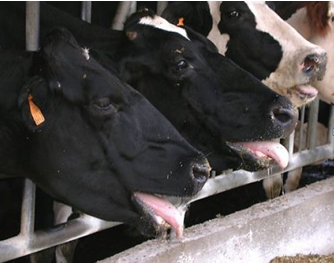INTRODUCTION
India with 192.49 million cattle and 109.85 million buffalo population ranks first in milk production (20th livestock census). This is attributable to the large scale crossbreeding programme where exotic breeds were imported and crossed with the low producing indigenous breeds. Though the production performance of the crossbreds is higher but their adaptive characters are far below the indigenous breeds making them susceptible to heat stress. Additionally, the temperature in the country goes beyond 45°C in summers which is above the upper critical temperature of dairy bovines. This rise in temperature along with humidity contributes to heat stress. Heat stress in tropical country poses great threat to the farmers and livestock owners as it causes huge economic loss. Therefore knowledge regarding management of heat stress is critical in terms of good health as well as wealth.
HEAT STRESS –CAUSES AND SIGNS
Heat stress is thermoregulatory change which is the result of imbalance between metabolic heat production and heat dissipation by the animal. There are various factors that cause heat stress in animals. These include:
- Environmental temperature
- Relative humidity
- Air movement
- Breed
- Body Colour
- Production performance
- Stage of gestation and lactation
- Amount of feed consumed
- Management practices
All these factors affect the amount of heat produced and dissipated by the animal. This in turn changes the behavioural, reproductive and productive performance of the animal. Behavioural changes serve as symptoms of heat stressed animal and include:

- Reduced feed intake
- Increase in water intake
- Increase in body temperature
- Prefers standing rather than lying
- Open mouth panting
- Excessive saliva production
- Animal moves to shade
- Rapid shallow breathing
- Unconsciousness
IMPACT OF HEAT STRESS ON PRODUCTIVE AND REPRODUCTIVE PERFORMANCE
Heat stress has an adverse effect on productive and reproductive performance of dairy cattle and buffaloes.
Reproductive performance: Service period is affected by calving season hence cows and buffaloes calved in summer months are heat stressed and have longer service period. Heat stress also decreases the conception and pregnancy rate in dairy cattle and buffaloes. It was found that the period from October- March is favourable for optimum reproductive performance whereas depression in fertility was witnessed during the months of April- September, May and June being the most critical months. Fertility is reduced owing to the deleterious effect of heat stress on oocyte maturity and early embryo development. Additionally pronounced variations in the signs of estrus, conception rate and calving rate is observed in heat stressed animals. Increased testicular temperature in bulls leads to fertility problems thereby declining the conception and fertility rate per insemination of the whole herd.
Productive performance: Heat stress reduces the productive performance of dairy cattle and buffaloes by reducing their dry matter intake and feed efficiency. Reduced milk production is the first visible consequence of heat stress. Heat stress also increases the somatic cell count in milk which is an indicator of infected udder. Also decrease in milk fat, SNF and milk protein is witnessed during peak summer months. Hence not only the production of milk is affected due to thermal stress but the composition of milk also changes which ultimately affects the pricing of milk in the market. Decrease in growth rate and average daily gain is also witnessed in heat stressed animals leading to economic loss for animals raised for the meat industry.

STRATEGIES TO REDUCE HEAT STRESS
The following practices are important in managing heat stress:
Environmental management: The most common approach to reduce heat stress is to modify the cattle and buffaloes’ immediate environment. This modification involves-
- Provision of shelter
- Thatching the roof using paddy straw or painting the roof white or providing false ceiling
- Evaporative cooling system in the form of water sprinkler, mist or fog with pump and timer
- Cooling ponds
- Barriers against hot wind using thatched wall or wet bags.
- Tunnel or cross ventilation
- Wallowing in water pond especially for buffaloes.
Nutritional management: It helps animal maintain homeostasis and also prevents nutritional deficiencies that the animal might face due to heat stress.
- Protein rich ration should be provided so that the animal doesn’t overeat since more energy is needed for digestion leading to excess heat production.
- Dietary fat content should also be increased. This enhances efficiency of milk production.
- Provide feed containing low fibre since heat production is linked with the acetate metabolism.
- Supplementation with vitamin A, C and E along with minerals such as zinc.
- Yeast product supplementation can also be done in order to improve the digestibility of nutrients in rumen.
- Greater proportion of feed should be given during night or early morning and increase in water availability.
Genetic selection: Long term strategies involve genetic selection so that the animals become adapted to the climate change. Different breeds and species have different level of thermal tolerance. Therefore genetic tools can be utilized to select thermo-tolerant animals. The preliminary selection involves selecting animals that can survive and maintain their high production level even in heat stressed condition. Such animals are characterized by shorter hair with greater diameter and lighter hair coat. The genes associated with these phenotype along with heat shock genes that are associated with thermo-tolerance can be identified and used in marker assisted selection and genome wide selection. Such thermo-tolerant animals can be further used in breeding programmes.

CONCLUSION
Heat stress or summer stress is a major problem in management of dairy cattle and buffaloes in India. During extreme hot and humid climate the thermoregulatory mechanism of the animal is hampered. These changes lead to decrease in production and reproduction capabilities and hence timely and efficient management of heat stress is vital for boosting the economy of dairy industry. However if the animal is found severely affected then immediate veterinary aid should be provided.

Dr. Sakshi Vaishnav; Dr. B.L Saini, Dr. Tapendra Saini















